#Amenemhat III
Text

Sphinx of Amenemhat III
Middle Kingdom, 12th Dynasty, ca. 1860-1814 BC.
Gray granite. From Tanis.
Egyptian Museum, Cairo. JE 15210
Read more
221 notes
·
View notes
Text

the statue of Sobek found at Amenemhat III’s mortuary temple as a testament of his devotion to Sobek
304 notes
·
View notes
Text
On Poimandrēs
The classical Hermetic literature (the Corpus Hermeticum, the Asclepius, the Stobaean Hermetic Fragments, etc.) generally take one of several formats: a monologue-type musing or speech (e.g. CH III or CH VII), a letter from a teacher to a student or between students sharing their wisdom (e.g. CH XIV or CH XVI), or a dialogue between a teacher and student (e.g. CH I or CH IV). By far the most…
View On WordPress
#amenemhat iii#coptic#Corpus Hermeticum#egyptian#greek#howard jackson#linguistics#ma`at#nimaatre#peter kingsley#poemander#poimandres#pymander#zosimos of panopolis
10 notes
·
View notes
Text
The Black Pyramid of King Amenemhat III: A Brief History
The Black Pyramid, constructed during the Middle Kingdom of Egypt, stands as a testament to the architectural and engineering prowess of ancient Egypt. Built by King Amenemhat III, the pyramid originally named “Amenemhet is Mighty” gained its nickname from its dark, weathered appearance, reflecting the ravages of time. Located in Dahshur, Egypt, it is one of the five surviving pyramids out of the…
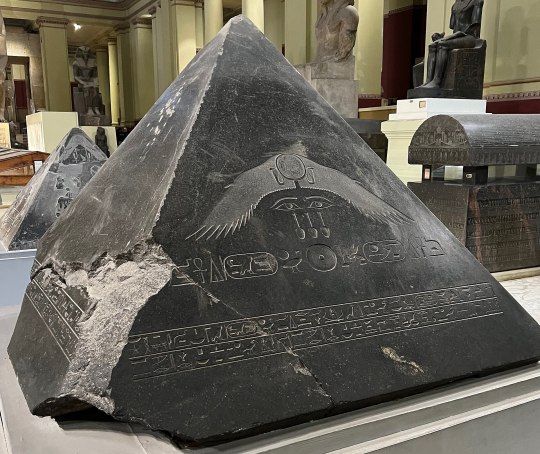
View On WordPress
#African architecture#African History#Amenemhat III#Ancient Egyptians#ancient egyptians history#Black Pyramid#King Amenemhat III
1 note
·
View note
Photo

Pyramidion of Amenemhat III
From the pyramid complex of Amenemhat III at Dahshur. Reign of Amenemhat III. The Middle Kingdom, 12th Dynasty, ca. 1860-1814 BC. JE 35133
845 notes
·
View notes
Text
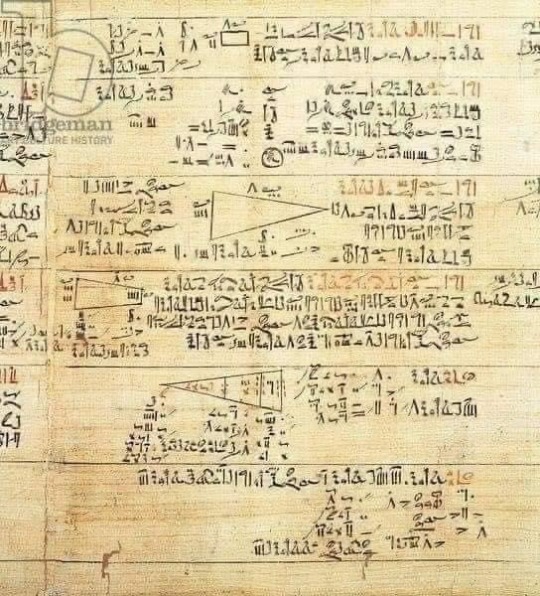
Rhind Mathematical Papyrus - the oldest (1650 BC) manuscript written in Algebra and Irigonometry.
"Rhind Mathematical Papyrus": It is named after Alexander Henry Rhind, a Scottish antiquarian. He bought the papyrus in 1858 in Luxor, Egypt. It was found during illegal excavations in or near the Ramesseum. The Rhind papyrus dates to the Second Intermediate Period of Egypt. It was copied by the scribe Ahmose from a now-lost text from the reign of Amenemhat III (12th dynasty).
The Papyrus is probably a mathematics textbook, used by scribes to learn to solve particular mathematical problems by writing down appropriate examples. The papyrus has work and writing on arithmetic, algebra, geometry, trigonometry, and fractions. Eighty-four problems are included in text covering tables of divisions, multiplication and handling of fractions; and geometry, including volumes and areas.
The scribe dated papyrus in year 33 of Apophis, the penultimate king of the Hyksos 15th Dynasty. The other side of the papyrus mentions 'year 11' without a king's name, but with a reference to the capture of the city of Heliopolis. In the opening paragraphs of the papyrus, Ahmose presents the papyrus as giving "Accurate reckoning for inquiring into things, and the knowledge of all things, mysteries... all secrets". He continues with: This book was copied in regnal year 33, month 4 of Akhet, under the majesty of the King of Upper and Lower Egypt, Awserre, given life, from an ancient copy made in the time of the King of Upper and Lower Egypt Nimaatre (?). The scribe Ahmose writes this copy.
223 notes
·
View notes
Photo



Part of the treasure discovered in the tomb of the 'King's daughter' Nubhetepti-khered in Dahshur, possibly a daughter of Hor Awibre also known as Hor I or of Amenemhat III; 13th dynasty of Egypt
#13th dynasty#mdpegypt#ancient egypt#ancient jewellery#jewellery#bracelet#pendant#costume#ancient egyptian costume#ancient costume#necklace
81 notes
·
View notes
Note
Hi just wanted to ask how r u? You seem cool and nixe and rlly into egyptology. Random question but who is the egyptian female ruler u like the most? And I agree hatshepsut is a bit overrated
Haha, being into egyptology is my job, yes! I'm doing ok, thank you for the sweet message :D
As for female rulers, I'm very particular to both Sobekneferu (Middle Kingdom) and Tawosret (New Kingdom). We don't know an awful lot about either, but Taowsret for example was dealing with a civil war so you've got a pretty interesting political situation going on there. Sobekneferu on the other hand succeeded Amenemhat IV but she legitimised her rule via Amenemhat III instead, so we're not exactly sure what her relation to A-IV was, which is again quite an interesting feature.
35 notes
·
View notes
Photo

Pyramidion of Amenemhat III (eastern face, from the pyramid in Hawara) - basalt - 1.40 meters (4.6 ft) high - Middle Kingdom - 12th Dynasty - c.1850 BCE
20 notes
·
View notes
Photo

Rectangular Carnelian and Gold Swivel Ring Swivel ring is carved in both in cameo and intaglio style with gold ring. 📷 1. funeral meal; man names Harbes 𓇉𓂋𓃀𓋴 “ḥA-r-b-s” (seated, short curly wig, smooth loincloth); lion-legged chair; offering table📷 2. massacre of prisoners; king (standing in the traditional pose of conqueror, wearing shedyt loincloth, red crown of lower Egypt , holding, hedj club in striking pose); a prisoner (on one knee). In the cartouche in the throne name Nimaatre 𓇳𓈖𓌳 “n-mAˁt-rˁ” ‘One who belongs to the Maat of Ra’ of the 12th dynasty pharaoh 𓉐𓉼 “pr-ˁ3” ‘Great House’ Amenemhat III (𓇋𓏠𓈖𓅓𓄂𓏏) “ı͗mn-m-ḥ3.ṯ”“Amun is in Front”. Dimensions Diameter: 1.85cm Material and technique carnelian, gold; cameo and intaglio Date of creation/manufacture: Ptolemaic period; Late Period (inscription/dedication/signature) (-664 -30 BC) 📸 @museelouvre (1-2) 𓋹𓎬𓋹𓎬𓋹𓎬𓋹𓎬𓋹𓎬𓋹𓎬𓋹𓎬𓋹𓎬𓋹𓎬𓋹𓎬𓋹𓎬𓋹𓎬𓋹𓎬𓋹𓎬𓋹𓎬𓋹𓎬 @egyptologylessons 𓋹𓊽𓋴𓆖𓎛𓇳𓎛 © 𓊁𓊁𓊁𓊁𓊁𓊁𓊁𓊁𓊁𓊁𓊁𓊁𓊁𓊁𓊁𓊁𓊁 #Ancientegypt #ägypten #egyptology #egypte #egitto #埃及 #مصر #egipto #이집트 #egyptianring #egyptianjewelry #carnelian #swivelring #amenemhatiii #pharaoh #cameo (at Louvre Museum Paris) https://www.instagram.com/p/CnUOeZfusF4/?igshid=NGJjMDIxMWI=
#ancientegypt#ägypten#egyptology#egypte#egitto#埃及#مصر#egipto#이집트#egyptianring#egyptianjewelry#carnelian#swivelring#amenemhatiii#pharaoh#cameo
24 notes
·
View notes
Photo
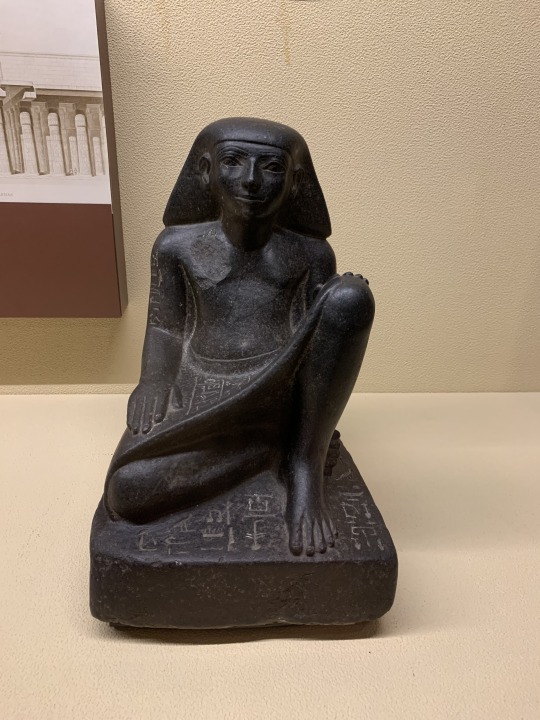
Statue of Amenemhat, Nubian provincial governor under Hatshepsut and Thutmose III
Temple of Horus, Buhen (Sudan)
18th Dynasty, ca. 1490 BCE
Penn Museum, E10980
65 notes
·
View notes
Text
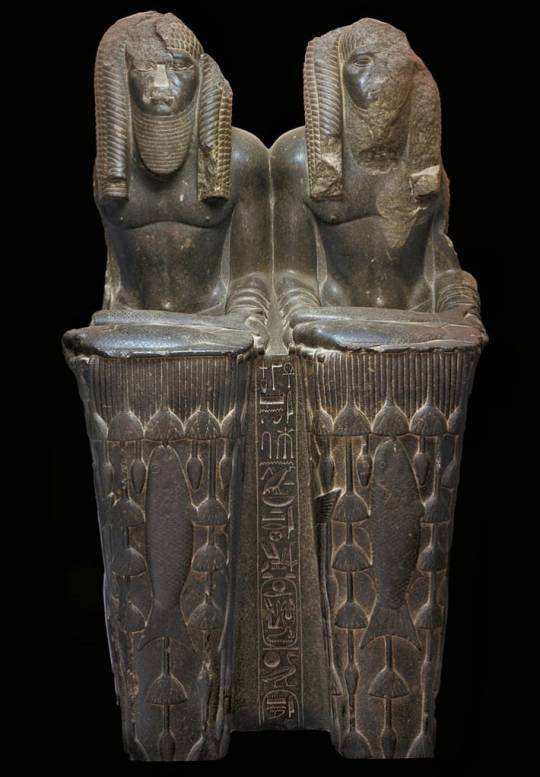
Statue of Amenemhat III as Hapi
This double statue of Amenemhat III as Hapi, the Nile god, was discovered at Tanis, capital of the 21st Dynasty Kings, however, the two male figures are clearly portraits of the 12th Dynasty king Amenemhat III.
They are carved with perfect symmetry, offering fish, birds, and aquatic plants. Both wear heavy wigs with large braids, wide beards, and finely pleated kilts. This representation of the king as Hapi is a novelty in royal statuary.
Middle Kingdom, 12th Dynasty, reign of Amenemhat III, ca. 1860-1814 BC. Now in the Egyptian Museum, Cairo. JE 18221
Read more
291 notes
·
View notes
Text
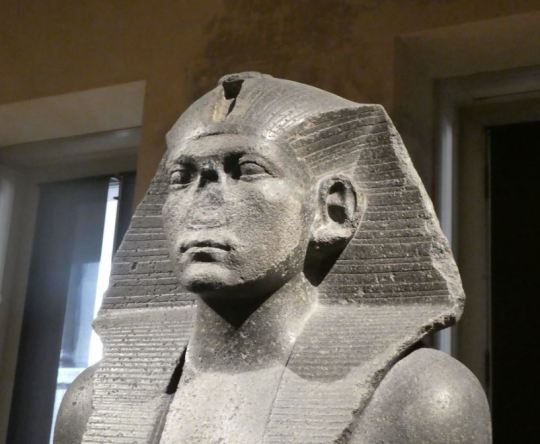
King Amenemhat III, statue, found at Memphis, now Berlin. Around 1800 BC.
4 notes
·
View notes
Text

These two figures, each wearing a heavy, braided wig and a broad beard with parallel stripes, bear offerings of fish, birds and aquatic plants. They represent the pharaoh Amenemhat III in the form of the Nile god Hapi, bringer of food and life. The statue associates the reigning king with fertility and abundance. 12th Dynasty, reign of Amenemhat III (about 1859-1813 BC: reused in the 21st Dynasty in the reign of Psusennes (about 1039-991 BC)
5 notes
·
View notes
Text
12 Facical Recreations Of Africa's Ancient Egyptian Pharaohs/Figures Based On Their Respective Sculptures
The 12 facial recreations of Africa’s ancient Egyptian pharaohs and figures based on their respective sculptures offer a captivating glimpse into the past. From the regal visage of Ahmose Nefertari to the serene countenance of Queen Tiye, each reconstruction brings history to life. The majestic presence of Amenhotep III and the enigmatic charm of Nefertiti are captured with remarkable precision.…
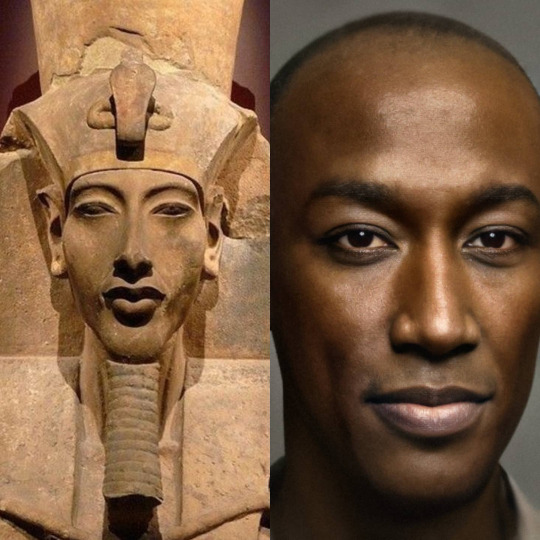
View On WordPress
#12 Ancient Egyptian Pharaohs Facical Recreations#African History#Ahmose Nefertari#Akhenaten#Amenemhat III#Amenhotep III#Ancient Egyptian Pharaohs Facical Recreations#Ancient Egyptians#ancient egyptians history#Djoser#Narmer#Nefertiti#Queen Tiye#Rameses II#Sahure#Senusret III#Tutankhamen
0 notes
Text
💥💥💥CONOCE LAS 6 FARAONAS DEL ANTIGUO EGIPTO
A lo largo de la vasta y rica historia del antiguo Egipto, varias mujeres asumieron el papel de faraón, una posición normalmente reservada para hombres. Sus reinados, aunque no tan frecuentes, destacaron por su fortaleza, sabiduría y, en algunos casos, por su habilidad para superar las adversidades políticas y sociales de su tiempo.
1. Merneith (c. 3000 a.C.): Aunque no se la conoce formalmente como faraona, Merneith fue una de las primeras mujeres en ejercer un poder significativo en el antiguo Egipto. Se cree que actuó como regente de su futuro faraón Den, durante la Primera Dinastía. Su tumba en Abydos, que es comparable en tamaño y magnificencia a las de otros faraones, es un testimonio de su estatus.
2. Sobekneferu (c. 1806-1802 a.C.): Reconocida como la primera mujer faraón confirmada, Sobekneferu gobernó al final de la Duodécima Dinastía. Su breve reinado marcó el final de la Edad de Oro del Reino Medio. Aunque su legado es escaso, se sabe que continuó con las construcciones iniciadas por su predecesor y hermano, Amenemhat IV.
3. Hatshepsut (c. 1479-1458 a.C.): Hatshepsut es, quizás, la más famosa de todas las mujeres faraonas. Inicialmente regente de su hijastro, Thutmose III, eventualmente se declaró faraona y gobernó en su propio derecho. Durante su reinado, Egipto experimentó un período de prosperidad y estabilidad. Fomentó el comercio, especialmente la expedición a Punt, y dejó un legado arquitectónico impresionante, incluido su majestuoso templo funerario en Deir el-Bahari.
4. Neferneferuaten Nefertiti (c. 1334-1332 a.C.): Aunque el debate sobre su reinado como faraona sigue siendo tema de discusión entre los egiptólogos, algunos creen que Nefertiti gobernó brevemente después de la muerte de su esposo, Akenatón, y antes de la ascensión de Tutankamón. Su reinado habría sido durante un período de grandes cambios religiosos y políticos.
5. Twosret (c. 1191-1189 a.C.): Gobernando al final de la problemática Decimonovena Dinastía, Twosret inicialmente sirvió como regente del joven faraón Siptah. Tras su muerte, asumió el control total, pero su reinado fue corto y marcado por conflictos internos y la inestabilidad política.
6. Cleopatra VII (69-30 a.C.): Aunque técnicamente no una faraona en el sentido tradicional, Cleopatra es indudablemente la gobernante femenina más conocida del Egipto antiguo. Hábil en política y lengua, gobernó como co-regente con varios miembros de su familia antes de convertirse en la única gobernante. Su reinado estuvo marcado por alianzas y conflictos con Roma, culminando en su trágica muerte y la incorporación de Egipto al Imperio Romano.
Estas mujeres faraonas desafiaron las normas de su tiempo y dejaron un legado duradero en la historia y cultura del antiguo Egipto. Sus historias son testimonio de su resistencia, liderazgo y la capacidad de las mujeres para gobernar en uno de los más grandes imperios de la antigüedad.
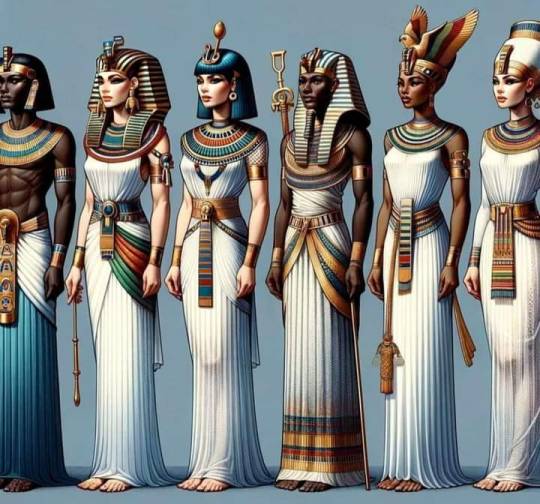
4 notes
·
View notes